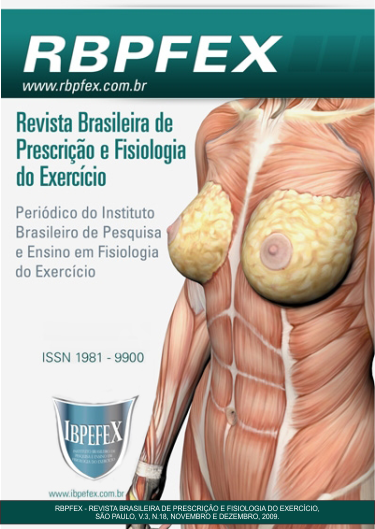Influence of the general and specific warm-ups on the upper body strength
Abstract
The aim of the present study was to verify the behavior of the muscular force in the bench press exercise after general and specific warm-ups. Participated in the study nine physically actives men (23.6±2.2 years; 77.7±6.6 kg; 170±10 cm), with an experience in strength training at least six months. The individuals were submitted to four sessions of collection of data accomplished in no consecutive days with intervals from 48 to 72 hours. In the first and second sessions, the test and retest of eight repetitions maximum (8RM) was accomplished and on third and fourth sessions were applied the training protocols that consisted of the accomplishment of the general or specify warm up and the subsequent accomplishment of three sets in the bench press exercise. To verify if there was difference between the numbers of repetitions maximum for sets intra and inter sessions, an ANOVA two-way for repeated measures was used, following by the post hoc Fisher LSD test when necessary, and to verify the differences in the total volumes of repetitions maximum produced the students test-t was used (p <0.05). It could be concluded that the two forms of warm ups, general and specific, can be used, because there was not significant difference in relation to the levels of force.
References
- Batista, D. A Importância do Aquecimento na Atividade Física. Revista Virtual EF Artigos. Vol. 1. Num. 6. 2003.
- Bishop, D. Warm Up II: Performance changes following active warm-up and how to structure the warm-up. Sports Medicine. Num. 33. 2003. p. 483-498.
- Fermino, R.C.; Winiarski, Z.H.; Da Rosa, R.J.; Lorenci, L.G.; Buso, S.; Simão, R. Influencia do aquecimento específico e de alongamento no desempenho da força muscular em 10 repetições máximas. Revista Brasileira de Ciência e Movimento. Vol. 13. Num.1. 2005. p. 25-32.
- Kato, Y.; Ikata, T.; Takai, H.; Takata, S.; Sairyo, K.; Iwanaga, K. Effects of specific warm-up at various intensities on energy metabolism during subsequent exercise. Journal of Sports Medicine and Physical Fitness. Num. 40. 2000. p. 126-130.
- Miranda H.; Fleck S.J.; Simão R.; Barreto A.C.; Dantas E.; Novaes J.S. Effect of two different rest period lengths on the number of repetitions performed during resistance training. Journal of Strength and Conditioning Research. Vol. 21. Num. 4. 2007. p. 1032-1036.
- Shellock, F.G.; Prentice, W.E. Warming-up and stretching for improved physical performance and prevention of sports-related injuries. Sports Medicine. Num. 2. 1985. p. 267-278.
- Shephard, R.J. PAR-Q, Canadian home fitness test and exercise screening alternatives. Sports Medicine. Num. 5. 1998. p. 185–195.
- Simão, R.; Giacomini, M.B.; Dornelles, T.S.; Marramom, M.G.F.; Viveiros, L.F. Influencia do aquecimento especifico e da flexibilidade no teste de 1RM. Revista Brasileira de Fisiologia do Exercício. Vol. 2. 2003. p. 134-140.
- Simão, R.; Senna, G.W.; Nassif, L.; Leitão, N.; Arruda, R.; Priore, M.; Maior, A.S.; Polito, M.D. Influencia dos diferentes protocolos de aquecimento na capacidade de desenvolver carga máxima no teste de 1RM. Fitness & Performance Journal. Vol. 3. Num. 5. 2004. p. 261-265.
- Tricoli, V; Paulo, A.C. Efeito Agudo dos exercícios de alongamento sobre o desempenho de força máxima. Revista Brasileira de Atividade Física e Saúde. Vol. 7. Num. 1. 2002. p. 6-13.
Authors who publish in this journal agree to the following terms:
- Authors retain the copyright and grant the journal the right of first publication, with work simultaneously licensed under the Creative Commons Attribution License BY-NC which allows the sharing of the work with acknowledgment of the authorship of the work and initial publication in this journal.
- Authors are authorized to enter into additional contracts separately for non-exclusive distribution of the version of the work published in this journal (eg, publishing in institutional repository or book chapter), with acknowledgment of authorship and initial publication in this journal.
- Authors are allowed and encouraged to post and distribute their work online (eg, in institutional repositories or on their personal page) at any point before or during the editorial process, as this can bring about productive change as well as increase impact and impact. citation of published work (See The Effect of Free Access).






